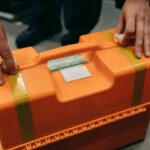When disaster strikes, communication becomes one of the most critical aspects of survival. Whether it’s a natural disaster like a hurricane, an extended power outage, or an unexpected emergency, staying connected with loved ones and emergency services can mean the difference between safety and peril. Emergency communication devices are essential tools that not only ensure connectivity but also facilitate better decision-making and coordination in survival scenarios. In this blog post, we’ll delve into why these devices matter, explore the different types available, and highlight best practices for their use.
Why Emergency Communication Devices Matter
1. Staying Informed
Emergencies are often fluid situations where conditions can change rapidly. Having access to reliable communication devices allows you to stay updated with important information such as weather alerts, evacuation orders, and safety guidelines. Without this information, you might find yourself exposed to unnecessary risks.
For example, a NOAA weather radio provides up-to-the-minute updates on weather conditions and disaster alerts, even when conventional communication lines like phone networks or the internet fail. This real-time information can help you make informed decisions, such as when to evacuate or which routes to take to safety.
2. Connecting with Loved Ones
During a crisis, the ability to contact family and friends is invaluable. Ensuring everyone’s safety and coordinating efforts are top priorities in such moments. Emergency communication devices enable you to check on loved ones, share your location, and confirm plans, even when cell towers are down.
3. Contacting Emergency Services
In life-threatening situations, being able to call for help is paramount. Devices such as satellite phones or personal locator beacons (PLBs) can transmit distress signals or connect you to emergency responders, ensuring that assistance arrives when you need it most.
Types of Emergency Communication Devices
There’s no one-size-fits-all solution when it comes to emergency communication. Different devices serve different purposes. Here’s an overview of the most common types:
1. Two-Way Radios
Two-way radios (or walkie-talkies) are excellent for short-range communication, especially in outdoor environments. They allow you to stay in touch with others in your group when cellular networks are unavailable. Look for radios with long battery life, weather resistance, and a decent range.
2. Satellite Phones
Satellite phones operate independently of terrestrial cell towers by connecting directly to orbiting satellites. These devices are ideal for remote areas or during large-scale disasters that disrupt traditional communication networks. Although they’re more expensive than other options, their reliability makes them indispensable in critical situations.
3. NOAA Weather Radios
These radios are specifically designed to provide weather updates and emergency alerts. Equipped with battery backup, they continue to work even during power outages. Some models also feature hand-crank generators for added reliability.
4. Personal Locator Beacons (PLBs)
PLBs are compact devices that send distress signals to emergency services via satellite. They are particularly useful for hikers, campers, and outdoor adventurers who might find themselves in isolated areas without any other means of communication.
5. CB Radios
Citizens Band (CB) radios are a tried-and-true option for longer-range communication. They’re especially popular among truckers and outdoor enthusiasts. While they require some setup, CB radios don’t rely on cellular networks or the internet, making them a dependable option in emergencies.
6. Mobile Apps with Offline Capabilities
While smartphones rely on cellular and Wi-Fi networks, certain apps (e.g., FireChat or Bridgefy) allow you to send messages using Bluetooth or mesh networking when traditional networks are unavailable. Pair these apps with a reliable power bank to keep your phone charged.
Best Practices for Using Emergency Communication Devices
Simply owning emergency communication devices isn’t enough—you need to know how to use them effectively. Here are some best practices to ensure you’re prepared:
1. Test Your Equipment
Regularly test your devices to ensure they’re functioning correctly. Familiarize yourself with their features, and make sure they’re fully charged or have fresh batteries.
2. Keep Backups
Redundancy is crucial in emergencies. Have multiple communication options available, such as a two-way radio and a satellite phone, in case one fails.
3. Store Devices Safely
Keep your communication devices in waterproof, shockproof cases to protect them from damage during disasters. Ensure they’re easily accessible in your emergency kit.
4. Plan Communication Protocols
Establish a clear plan with your family or group for how you’ll communicate during emergencies. Decide on meeting points, backup devices, and specific times to check in.
5. Monitor Battery Life
Conserve battery life by using devices sparingly and carrying backup power sources like solar chargers or power banks. Consider hand-crank generators for radios and flashlights.
6. Learn Emergency Frequencies
Familiarize yourself with emergency radio frequencies and channels for your area. Knowing which frequencies to tune into can save precious time during a crisis.
The Future of Emergency Communication
Advancements in technology are continuously improving the capabilities of emergency communication devices. For instance, newer satellite devices integrate GPS navigation and SOS functions, making them multi-purpose tools for survivalists. Additionally, innovations in mesh networking and low-power communication protocols are making devices more accessible and reliable than ever.
Final Thoughts
Emergency communication devices are a cornerstone of preparedness, providing critical links to information, loved ones, and assistance in times of need. Whether you’re facing a natural disaster, a remote wilderness adventure, or an unexpected crisis, these tools can help you navigate challenges with confidence and clarity. By understanding their importance, choosing the right devices, and following best practices, you’ll be better equipped to protect yourself and those around you.







Leave a Reply